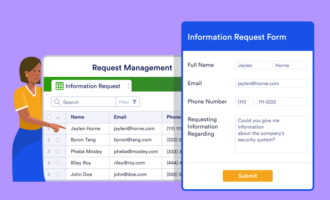How does work actually get done in your organization?
Maybe each team member can refer to clearly documented steps to accomplish their major objectives, or maybe your staff get daily emails that outline tasks to complete. Or perhaps everyone just shows up to work with a general idea of what needs to happen and goes with the flow. Whatever the case, workflow management plays a role in every organization to some degree.
So what exactly is workflow management? How do you practice it effectively? What kind of technology can help? Knowing the answers to these questions — and applying that knowledge — can improve your company’s profitability and efficiency.
Workflow management explained
Workflow management is the process of identifying, organizing, and coordinating a specific set of tasks that result in a specific outcome.
“The term ‘workflow’ has become a bit of a buzzword in the business world. While most business owners can conceptually understand why workflow is important, it’s difficult to truly grasp it until you’ve seen it in action,” says Vincent Talbot, founder and chief editor of 99CarStereo.com.
Sara Bandurian, operations supervisor at Online Optimism, adds that the “flow” part of the work is critical. Tasks often have to go in a certain order to properly achieve your desired outcome. Managing the flow means not only deciding on which tasks go first, second, and third, but also who’ll be responsible for each task and what a handoff from person to person will look like.
“This helps keep work moving efficiently, especially when there are many moving pieces in a workflow,” Bandurian explains. “Without workflow management, there is often chaos — team members may be unclear on where their work comes into play and delay not only other members’ work, but also the desired outcome of the workflow.”
Workflow management has become even more important in recent years with the rise of remote work. As employees have left the office — and the often longstanding workflows that have been in place — businesses have had to rethink how they can achieve their desired outcomes with their teams in different locations.
Pro Tip
Read our comprehensive workflow guide to learn how you can optimize workflows for your business.
The purpose of workflow management
Workflow management is all about optimizing, improving, and, especially today, automating workflows to increase output, eliminate repetition, and reduce errors wherever possible.
For example, Talbot says many workflows include redundant steps that reduce efficiency. “Practicing effective workflow management helps the team better identify these steps and eliminate them, thereby saving time and, in some cases, reducing opportunity for error.”
The function of a workflow management system
A workflow management system is a tool or software solution you can employ to make workflows more efficient, typically by digitizing and automating applicable tasks.
“These systems enable automated and seamless workflow execution by giving users the ability to model the flow of steps, set constraints, and select the environments in which they want to execute,” Talbot explains. “The systems then evaluate these inputs and execute them accordingly.”
Implementing a workflow management system at Online Optimism
Bandurian’s team uses a project management solution as their workflow management system. With the solution, they’re able to create and organize tasks, color code tasks to keep them coordinated, and track progress toward completion. “Having a centralized system that everyone understands helps keep our workflows — and people — on track.”
Bandurian was the first operations person at her small company. The CEO was wearing multiple hats — formulating strategy, handling operations, and acting in other functional roles. While the company was operating fine before she joined and implemented a formal workflow management system, the CEO saw noticeable improvement within just a few weeks.“
Many of our workflows were manual before implementing the system, and that led to some understandable lag and the occasional ball being dropped,” says Bandurian. “Now everyone is on the same page, and workflows are completed smoothly across the company. We’re also able to better prioritize work as business needs change.”
Initially, Bandurian’s team was wary of the change since they had been performing workflows the same way for some time. However, even they admitted work life was easier with the new technology in place.“
In addition, having a system with built-in visibility and auditability gave the CEO comfort — he could hand over the operational reins without much worry since he was able to easily verify any questions he had about work status,” Bandurian explains. “With our CEO now able to spend more time on strategy — coupled with the support of our workflow management system — our company is now in a position to scale like never before.”
Key workflow elements
A workflow is generally made up of three parts: input, transformation, and output. Here, we’ll use a customer feedback workflow example to illustrate each component.
- Input. This refers to the materials or information that are needed to begin the workflow. If a business is trying to gather customer feedback, the input would look like the request to gather feedback on a certain topic, the content being surveyed, and the list of customers being contacted.
- Transformation. This is the part where inputs are processed and turned into something more concrete. In our example, transformation would look like building your customer feedback form, finalizing it, and sharing it via link, email, or website embed.
- Output. The output is the final results of your workflow. In our case, the customer feedback received through the survey would be the output, which could then trigger a new workflow by serving as input for a feedback analysis workflow.
There are additional components of a workflow to keep in mind, such as actors, activities, results, and states.
- Actors are the individuals or groups that play a part in the workflow. In our example, this can include the marketing representative who requests feedback, the employee who builds the form, and the manager who looks over and approves it.
- Activities are the tasks or processes that happen within the workflow, step-by-step. Building the form is one activity, while filling it out is another.
- Results are the workflow outcomes you want. In the feedback form workflow, constructive feedback would be the desired result.
States are project statuses in between workflow steps. For instance, if the form requires approval from a manager before it’s shared, preapproval would be one project state.
4 workflow management best practices to follow
1. Ensure workflows are clear and easy to follow
Your team needs to understand exactly what steps are required to complete your desired objectives; otherwise, your business won’t meet those objectives with any consistency. Take care not only with training your employees how to perform workflows, but also documenting workflows for both new and tenured employees.
2. Update workflows regularly
Designing clear workflows isn’t the end of the road — it’s important to revisit them periodically to ensure they’re still relevant as market demands and operational needs evolve.
3. Try different workflow management systems
When you’re searching for a workflow management system, it may be tempting to go with the first one that seems to work well and fits your budget. Bandurian says it’s important to do your due diligence in testing out several different systems to identify the one that provides the greatest overall value for your company.
“There’s no one-fits-all solution, even if one is highly rated and used by many businesses,” Bandurian explains. “Your industry or specific type of business may benefit better from another option. So don’t hesitate to use the demos and free trials many of today’s solutions offer.”
4. Get buy-in from your team
Bandurian says it’s also crucial that you don’t simply select a solution and implement it without getting input from those who’ll use it: your workforce. “Not only does seeking input from different functional areas and teams ensure you choose a solution that addresses as many needs as possible, but it also makes it much more likely for your workforce to actually use the solution.”
3 workflow management system features to look for
1. Notifications
Bandurian says one key feature any workflow management system should have is the ability to automatically notify users of different events. For example, if a task is due soon, the system should let the assignee know in advance, such as one week before, one day before, and on the due date.
“This feature was key for helping our team stay on top of timelines,” she says. “They’re human — even the most diligent ones forget things, especially when they’re juggling multiple tasks.”
2. Automation
One of the key aspects of a workflow management system is automation. Bandurian says a good system should help you automate work as much as possible, whether that’s sending an invoice to a customer, creating new tasks once other tasks are finished, or moving a vacation request along in an approval workflow.
3. Forms
Bandurian says workflows that are based on traditional tools like email slow operations down because they lack a unifying organizational structure. “It’s important to have a way to capture and share information easily, such as through forms. A good system will let you create and share forms with various stakeholders, then automatically move and track the forms through a workflow you designed.”
Seamless workflow management with Jotform
Whether you’re collecting information or assigning tasks, Jotform is a powerful platform that can help teams create and manage workflows. Jotform offers a drag-and-drop workflow-building product you can use to automate notifications and approvals, integrate with other software tools, assign tasks, and more. Here are just a few Jotform tools that can help streamline processes and workflows:
- Jotform Workflows: Need to build a workflow for payment requests, project reviews, HR approvals, or other key functions in your business? Take advantage of our intuitive, no-code workflow builder so automations can handle tasks on your behalf. Use one of our many ready-made templates, or make a workflow from scratch to ensure information gets to the right people at the right time.
- Form templates: Whether you’re collecting information from customers, employees, or suppliers, use any of our 10,000-plus form templates (including fillable PDFs) to capture and act on information.
- Table templates: Take information collection to the next level with one of more than 300 templates in Jotform Tables, a spreadsheet-inspired database management system for collecting and organizing data in one place.
Photo by Tima Miroshnichenko





















































































Send Comment: